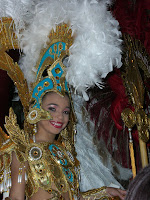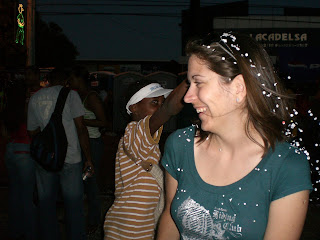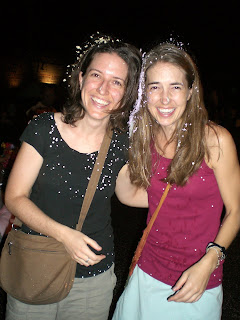 Coming soon: a photo journal of my trip to Panama with Ian (my older brother), Kirsten and Nathaniel (cousins who share my love of travel) and my friend Tara, who's teaching in Panama City this year. In this long-overdue entry I'll focus on Carnaval. This isn't the first time in my travels that I've unintentionally been present for a major festival. I didn't actually plan to be in Latin America for Carnaval, but after coordinating our available dates, that's how the timing worked out - and it sure was a fun bonus!
Coming soon: a photo journal of my trip to Panama with Ian (my older brother), Kirsten and Nathaniel (cousins who share my love of travel) and my friend Tara, who's teaching in Panama City this year. In this long-overdue entry I'll focus on Carnaval. This isn't the first time in my travels that I've unintentionally been present for a major festival. I didn't actually plan to be in Latin America for Carnaval, but after coordinating our available dates, that's how the timing worked out - and it sure was a fun bonus! Ian and Nathaniel had left already, but I had a blast celebrating with Kirsten and Tara; the three of us started by checking out the festivities in Panama City. Just after we had gone through a security gate and started up the long, long street blocked off for the occasion, I felt a tap on my shoulder. I turned to see who it was, and a teenage boy with a wide smile said "Welcome to Panama" - and then threw a handful of confetti in my face. That was just the start of what we'd have thrown at, sprayed on, squirted at, and sprinkled on us that evening. It wasn't long till we decided that we should arm ourselves, so we bought some confetti of our own - four small bags for a dollar. Then we continued up the street, stopping at vendors along the way to try kebabs and grilled sausages and plantain chips and popcorn, watching the flame throwers and flame eaters and the little girls in their polleras and the guy lying on a bed of nails, all the while tossing our confetti on our fellow Carnaval-ers. We learned fast that it was best not to target the kids wielding cans of silly string or colored spray foam, which goops and mats when it's squirted in your hair.


That was a fun evening, but not quite as outrageous as I'd always imagined Carnaval to be. The next afternoon Tara and I saw Kirsten off to the airport and then headed to Las Tablas, a town in the Panama interior which is apparently THE place to celebrate Carnaval in Central America. We arrived late in the afternoon, just as all the Carnaval-goers were heading home for a siesta and dinner and a change of clothes before returning to the city center for the parades and other evening festivities. We called Tara's colleague Estavia, who's from that part of Panama and had invited us to stay with her, to let her know that we'd arrived. After about 15 minutes she showed up in her giant SUV and whisked us off to the beach. We went for a quick swim and then ate overlooking the Pacific - tasty grilled fish for me. Then we went to Tara's colleague's daughter's friend's grandparents' house (at least I think I got that right; Tara and I weren't always exactly clear on who was who or on where we were going when), to change and head back down to the square in Las Tablas. We got there about 10:00, and at 10:30 or so the parades started.
Each year in Las Tablas there are two competing Carnaval queens representing two streets in the city; residents are loyal supporters of one, though I'm not sure whether that's based on where they live in the town or if it maybe changes from year to year depending on whether the queen is a friend or neighbor or relative. Twice each day for four days the queens ride around the center of town on elaborate floats - different floats each time, and always wearing different garb. Each queen's float is preceded by another elaborate float with her court, also in costume, and followed by a third float with a vibrant brass and drum band. They can't move very fast becuase the streets are so packed; the crowd kind of makes way as the tractor pulling each float nears, and then the people either cheer or jeer for the queen as she passes. Estavia told us that the opposing side is quick to point out any blunder on the part of one queen or her crew; this year, for example, one queen was seen taking some aspirin and the other camp promptly started working on a song about why her support staff was giving her pills. We stayed out till 2am that night(significantly later than Kirsten and Tara and I had stayed out in Panama City. I'm embarrased to admit how early we went home, but I will say that our cab driver was laughing at us and telling us that we should try an energy drink like Red Bull or some caffeine pills).
The next day we headed back to the center of town for the daytime celebration - Culeco - which is apparently a Panamanian word that's difficult to translate. Estavia explained it as the state of an egg just before it hatches; her daughter translated it as hyper. Now that I've experienced it, I'd say it means something like the most fun I've ever had on a Monday in February. Or maybe the happiest, densest crowd I've ever been a part of - with a Queen's Day celebration in Amsterdam a very close second. Anyway, it was crazy good fun; I've never been to Mardis Gras or to Carnaval in Rio, but I think I now have a sense of what they must be like.
It was a hot sunny day, and several tank trucks filled with river water were parked around the square; people on top were dancing and hosing down the crowds on the streets below. In houses around the square people had strung hoses through their apartments so that they could also send water from their balconies out over the crowds. The queens circled on their floats, and the bands kept everyone's toes tapping and hips swinging and lips smiling as the masses sang along when the tune was familiar and cheered wildly when their queen came past.
We'd been warned about the water, so I didn't have my camera with me for Culeco. Too bad, because we had a great view from Estavia's former math teacher's balcony (at least I think that's whose balcony it was) on the square. I'm not sure if pictures would do it justice, though; I'd read about it and seen pictures before we went, and I'd even been in Las Tablas with Kirsten and Nathaniel and his uncle and aunt earlier in the week to see the floats and other preparations in progress, but I still didn't have a good sense of what it would be like. I think it's one of those things that you really have to experience to fully appreciate, but I hope this at least gives you a general impression of what our time there was like!